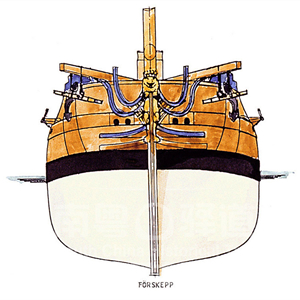Chinese beautiful white translucent glazed porcelain was brought to Europe by Portuguese merchants from Canton in the early sixteenth century, which was in blue and white pattern, known as 'Kraak Ware”, and transported by Portuguese carracks or trading ships. Some of the earliest blue and white pieces from this time showed Portuguese coats of arms[1].In fact, The ship departure from Canton port carried Chinese export tableware, including thousands of Chinese armorial porcelain.
Riddarhuset (House of Nobility) is located on Gamla Stand in Stockholm. The architecture was designed by Simon de la Valleen (1590-1642), Heinrich Wilhelm and Joost Vingboons in 1660. There is a room call “Blue Room”, exhibiting a collection of some 300 pieces of China adorned with coat of arms belonging to Swedish noble families.

The Chancellery of Riddarhuset in Stockholm is call “Blue Room”, there are collects of Chinese armorial porcelain

Riddarhuset in Stockholm
More and more Chinese are visiting Stockholm Sweden nowadays, however few know there is a Chinese-inspired royal Pavillion at the Drottningholm palace in the city, which was built between 1753-1769. The walls in the Yellow Room are covered with Chinese lacquered panels, showing the scenes from Canton by the Pearl River and the European Thirteen Factories. The rooms of the Pavilion are full of Chinese style items that were brought by Swedish East India Company, including porcelain, silk, lacquers,etc.

Yellow Room of Chinese Pavillion at Drottningholm was built between 1753-1769

The entrance of Chinese Pavillion in Drottningholm palace
Swedish East India Company was founded in 1731 and ceased trading in 1813. Swedish merchant from Gothenburg have been given a chart by King Freder for fifteen years. A swendish merchant from Gotherburg, Nicholas Sahlgren, invited Colin Campbell(1689-1757) ,the younger son of an Edinburgh lawyer ,to join the Company, who latterly became one of the Directors of the Company until his death in 1757[2] . It is the reason that there are few services which having been ordered from Sweden by Scotland and British family, In 1732, first voyage was Fredericus Rex sailed to Canton, anchoring on September 1732.

Colin Campbell ordered Chinese armorial porcelain in Canton with the coat arms of Campell family, made in Scotland style in Guthenburg Musume
The Grill Trading House played an important role in the Swedish East India Company in the second half of 18th century, Abraham Grill(1701-1768) and Jean Abraham Grill(1736-1792) were key person in the Company. They ordered a lot of Chinese armorial porcelains for their family. The Gharge of Grill family coat of arms are the Crane and Cricket, in Italian “Grillo”means the cricket. The coat arm is cantting coat of arms.

Chinese armorial porcelain of Grill family
The Ship Gotheborg of the company has a long story. Built in 1745, her third voyage reached Canton in the summer of 1774. After 6 months trade stop the ship went back home. After 30 months on the sea, the ship sank off 900 meter far away from Gothenburg when she was approaching the habour, Fortunately everyone on board was saved. In 1986 to 1992, the exavactions were finished and the research was completed when an idea of creating a replica of the ship was born. In 1995 the replica of the 18th century ship in full 1:1 was built without any of original drawings, who arrived Pearl River Delta in 2007. Swedish delegation on this ship presented a special gift, a model of Guthenburg., to China Guangdong Provincial government, in memory of the Gethenburg’s original visit to Guangzhou.

Model of Guthenbourg, in Guangdong provincial government

The decorate detail of Model of Guthenbourg

The drawing of the ship. Retrieved from http://www.pictures.soic.se

Historic route from Gutherburg to Peal river delta. Retrieved from http://www.pictures.soic.se
From 1695 to 1820 , 4,000 services of Armorial ware were imported from Canton by British clients. How to paint the Arms in a correct way. Amongst the painters work books in the College of Arms are accounts for arms and crests supplied to Wedgwood. Liverpool workshops from about 1760 to 1770. The City Livery Companies of London commissioned many fine services in the eighteenth (mainly from China) and nineteenth centuries, many of which are displayed and occasionally used today.
From the 1720s onwards , the Meissen factory was producing a pure white porcelain, often decorated in imitative Chinese styles.
Today, over 4000 China made heraldic porcelain services for British market are recorded as in at least part existence, and more are being discovered every year. They are highly decorative and have become much sought after and internationally collected, both for their heraldic interest, and as investments. This subject has a huge fascination to those who interested both in heraldry and the development of the China Trade[3]. The history of heraldic porcelain, rather like hall-marked and crested silver, is there to be researched and discovered in so many beautiful objects. An added bonus for collectors is that heraldic porcelain has proved to be not only a delight to the eye, but a sound investment over the decades.
Notes:
1. An introduction to Heraldic Porcelain By Hugh Macpherson. FSA Scot. London, November 2010
2.Chinese Armorial Porcelain by David Sanctuary Howard Volume II,Published 2003 Heirloom & Howard Ltd, 51p
3.Chinese Armorial Porcelain by David Sanctuary Howard Volume II,Published 2003 Heirloom & Howard Ltd
责任编辑:江家敏